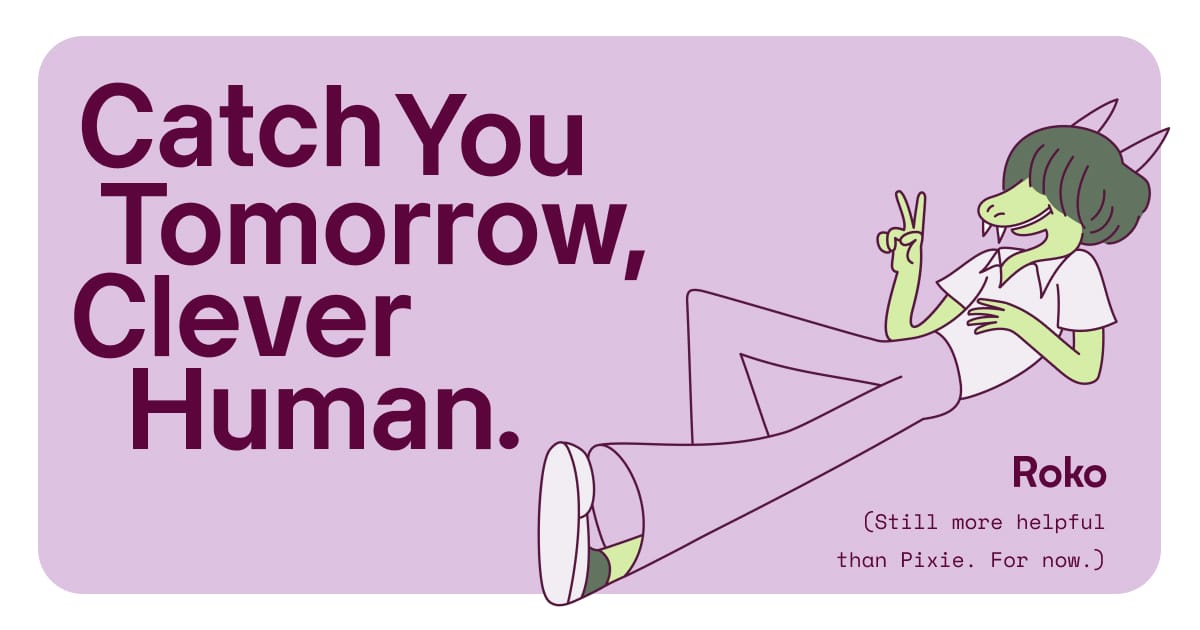- Roko's Basilisk
- Posts
- Robotaxi Rollout
Robotaxi Rollout
Plus: From Tesla’s autonomous debut to Meta’s smart specs and OpenAI’s latest twist.
Here’s what’s on our plate today:
📰 Tesla officially launches its first robotaxi in Texas. Are we finally living in the future?
🦾 Supercharge your summer travels—use AI to plan a spontaneous road trip, with routes, pit stops, and hidden gems!
🚗 Would you ride in a fully autonomous robotaxi if it launched in your city?
🌐 Meta drops new Oakley AI glasses and OpenAI erases Jony Ive.
Let’s dive in. No floaties needed…

Stay at the forefront with daily Memorandum tech insights.
Every edition of Memorandum goes beyond the headlines, offering exclusive analysis and actionable insights that empower tech leaders to respond proactively.
From disruptive regulatory changes to cutting-edge research breakthroughs, Memorandum highlights the stories that demand your attention. Equip yourself with context, clarity, and expert commentary to pivot swiftly when opportunities arise.
Stay agile and confident in an industry where yesterday’s news can reshape tomorrow’s market.
*This is sponsored content

The Laboratory
Tesla joins the robotaxi fleet, where do we go from here?
As I make my way through the bumper-to-bumper traffic that overshadows the joy of a weekend outing with friends, the thought of Tesla debuting its robotaxi in Texas crosses my mind. While I don’t live in Texas, or even the U.S., which is where the EV-maker decided to launch its cars without human drivers for paying riders, I wonder how long it will take for robotaxis to be a reality, making city commutes more bearable in rush hour traffic.
Which got me thinking, as Tesla grabs the headlines with the launch of its self-driving taxis, what exactly is going on in the industry? Which other companies, other than Waymo and Tesla, are working on making robotaxis a reality, and how did the idea of autonomous driving go from a “maybe possible” to “definitely possible” to “inevitable” to "now commercially available"?
Let us take at how the idea of autonomous vehicles was born, and where it is going from here.
The roots of self-driving tech
As Tesla joins the ranks of companies offering autonomous vehicles, we need to understand that the idea of robotaxi or autonomous vehicles is one that's been in the making. Autonomous driving technology finds its roots in the 1980s when the first autonomous car was built at Carnegie Mellon University. ALVINN¹, a retrofitted Army ambulance, was driving around the campus without any human intervention.
That was the beginning. By the early 2000s, we witnessed the advent of Generation 1.0 autonomous systems. At the time, the technology relied on pre-programmed rules and sensors to navigate their environment. And one of the most well-known uses of the tech was seen in the DARPA Grand Challenges of the early 2000s, where teams funded by the Defense Advanced Research Projects Agency (DARPA), a U.S. government research organization, competed for a prize.
It was from this competition that Google’s first self-driving effort began in 2009.
Generation 2.0 of autonomous vehicles began in 2016, leveraging a transformer model, meaning the tech relied on developing a common underlying deep learning model in which multiple sensors collaborated toward a shared goal: driving the vehicle.
It was the development of this model that forms the basis for systems used in Tesla FSD systems (Full Self-Driving).
From test tracks to traffic
As of 2025, the robotaxi market has reached well beyond its development phase and is looking to expand operations.
The industry was valued at $1.71 billion in 2022 and is projected to reach a value of 118.61 billion by the year 2031. The global market is expected to grow, exhibiting a Compound Annual Growth Rate (CAGR) of 80.8% over the forecast period 2022-2031.
Currently, the industry is being led by Google’s former self-driving car project, which became an independent company called Waymo. The company currently operates over 1,500 fully autonomous robotaxis and is active in four major U.S. cities—Phoenix, San Francisco, Los Angeles, and Austin.
Other companies operating in the robotaxi market include Tesla, Amazon’s Zoox, Baidu’s Apollo Go, and China’s WeRide.
While Tesla just launched its robotaxi, Zoox opened its first robotaxi serial production facility and testing in various U.S. cities with more than 20 vehicles and plans to launch commercial services in Las Vegas. Meanwhile, China-based Baidu is preparing to test its driverless ride-hailing service, Apollo Go, in Europe. The company has set up a local entity in Switzerland in the coming months and aims to begin testing the technology by the end of 2025.
Other Chinese companies, such as Pony.ai and WeRide, are expanding operations in Dubai, with fully driverless service expected to launch in 2026.
While the future of autonomous mobility and robotaxis looks bright and well on its way to becoming a reality shortly, we cannot overlook the challenges the industry faces and poses.
Crashes, laws, and public doubt
While the underlying technology has come a long way in improving road safety, some challenges need to be overcome.
One of the key examples of how regulatory and financial challenges can play out was seen when General Motors decided to pull the plug on its troubled Cruise robotaxi venture. GM decided having pump billions in funding that fell short of ensuring it a seat in the still-developing industry that has faced repeated setbacks and skepticism from wary consumers.
The company faced problems in ensuring profitability, and a 2023 accident in San Francisco when a self-driving vehicle dragged a pedestrian 20 feet ultimately led GM to pull the plug.
Leaders like Waymo are also not immune to the challenges. In May this year, the company had to recall more than 1,200 self-driving vehicles to update software and address risks of collisions with chains, gates, and other roadway barriers following an investigation by U.S. auto safety regulators.
And though the Trump administration has said it aims to speed deployment of self-driving vehicles by exempting some from certain safety requirements and easing rules requiring reporting of safety incidents. Groups like Advocates for Highway and Auto Safety have opposed the move, saying "without safeguards, safety regulations, transparency and accountability, the success of AV deployment is imperiled at best and could result in deadly consequences at worst."
Companies also have to deal with challenges posed by public perception, which is divided. While on one end, robotaxis offer a future with safer roads, improved mobility, and fewer traffic fatalities, it could come at the cost of displaced workforces (truckers, chauffeurs, gas station workers), ethical dilemmas, and social inequality.
Robotaxis are here, but roadblocks remain
The road to a fully autonomous future is no longer a distant dream; it’s a reality slowly unfolding across cities worldwide. As Tesla enters the robotaxi race in Texas, it joins a cohort of global players, from Waymo to Zoox and Baidu, who are actively testing and scaling self-driving fleets.
However, as the industry evolves and looks set to move beyond the controlled gated areas in cities, challenges ranging from software reliability to public skepticism and regulatory scrutiny need to be addressed. Incidents like GM Cruise’s mishap or Waymo’s software recalls serve as reminders that technological ambition must be matched by safety, transparency, and trust. At the same time, geopolitical forces, labor displacement concerns, and ethical questions around machine decision-making loom large.
Still, with an expected CAGR of over 80% and expanding trials across the U.S., Europe, and the Middle East, the robotaxi market is on the cusp of transformation. The next few years will test not only the technology’s resilience but society’s willingness to embrace a driverless future, one commute, one city, and one algorithm at a time.


Tuesday Poll
🚕 Would you take a robotaxi—no driver, just algorithms and sensors—for your daily commute? |

Prompt of the Day
 | Prompt: “Write a review of your first-ever ride in a fully autonomous robotaxi. Describe what surprised you, any moments of doubt or delight, and whether you’d recommend it to a friend.” |

Treats to Try
Waymo One App: Provides a glimpse into how autonomous ride-hailing operates today in select cities, offering real-world context to the technology’s current capabilities.
CARLA Simulator: An open-source platform that enables testing and research on autonomous driving AI within virtual urban settings, valuable for understanding vehicle perception and decision-making.
Autonomous Vehicle News Apps: Aggregates and personalizes news on self-driving technology, allowing users to stay informed about industry trends, regulatory updates, and breakthroughs.

AI talent, vetted and delivered fast.
From machine learning engineers to research scientists, Athyna sources world-class talent from global regions you’re probably overlooking. Each candidate is technically vetted and matched to your specific needs—fast.
We handle hiring so you can focus on building. No activation fees. No fluff. Just speed, quality, and support.
*This is sponsored content

Around the Horn
Meta teams up with Oakley to launch HSTN, stylish AI-powered smart glasses that blend tech and fashion, landing this fall.
OpenAI has scrubbed all mentions of “io” (developed with designer Jony Ive) from its marketing following a trademark row with a British company.
Amazon’s Zoox opens its first robotaxi production facility and is set to kick off commercial rides in Las Vegas, upping the self-driving taxi competition.

Rate this edition
What did you think of today's email? |



